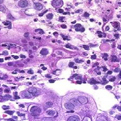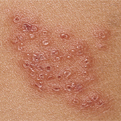Herpes Zoster
General Information
Varicella-Zoster Virus Infection initially produces chickenpox. The virus will lay dormant in a patient until focal reactivation along a ganglion’s distribution results in herpes zoster (shingles). An average of about 20 percent of people who have had chicken pox will develop the zoster virus. The symptoms may include a burning sensation, pruritus, tingling, or extreme sensitivity in the affected area, it is usually limited to one side of the body. Patients may also complain of headaches or fever. The symptoms may be present for anywhere between one to three days prior to a rash that develops. The rash converts into blisters that last for around two to three weeks. The blisters start out clear but then look yellow or bloody before they crust over (scab) and disappear. Initial therapy may include nonsteroidal anti-inflammatory drugs (NSAIDs). In many cases, narcotic analgesia is necessary. Wet dressings with tap water or 5% aluminum acetate (Burow solution) and apply to affected skin for 30-60 minutes 4-6 times per day. Lotions (ie, Calamine) may help relieve discomfort.
Epidemiology
95% of adults in the United States have antibodies to the varicella-zoster virus. Occurs annually in 300,000-500,000 individuals
Etiology
Unknown; however, decreased cellular immunity is a causative factor
Pathogenesis
Manifests as a vesicular rash, usually in a single dermatome
Clinical
Rash in a unilateral dermatomal distribution; the rash may be erythematous, vesicular, pustular, or crusting, depending on the stage of disease
Histology
Intraepidermal vesicle produced by profound degeneration of epidermal cells, resulting in marked acantholysis
Bibliography
1. “Herpes Zoster” (Online). http://www.aad.org/public/publications/pamphlets/viral_herpes_zoster.html (visited: March 18, 2008) 2. “Herpes Zoster” (Online). July 2006 http://www.emedicine.com/EMERG/topic823.htm (visited: March 18, 2008)
Download PDF
![]() Herpes Zoster
Herpes Zoster


